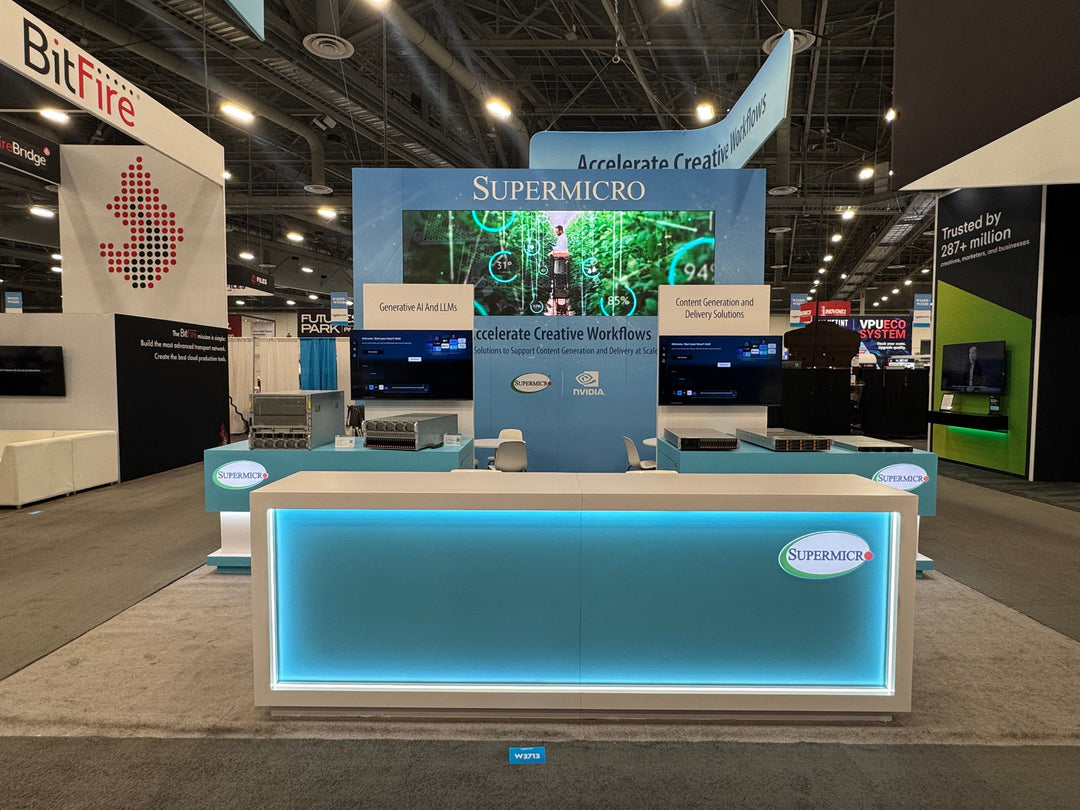The Next Frontier in Trade Show Innovation
The trade show industry has seen transformative change over the last decade—from modular booths and experiential design to the integration of cutting-edge technologies like augmented reality and interactive displays. But one of the most promising innovations reshaping booth design and pre-show planning today is digital twin technology.
Originally developed for manufacturing, aerospace, and smart cities, digital twin technology is now finding a strong foothold in the world of trade shows. This powerful tool enables exhibitors and fabricators to create hyper-accurate virtual replicas of their booths before they’re physically built—offering a revolutionary way to plan, optimize, and execute show presence with unprecedented precision.
In this article, we’ll explore how digital twins work, why they matter, and how businesses can leverage them to enhance trade show performance. We'll also share best practices and real-world examples to help you take advantage of this emerging technology.
What is Digital Twin Technology?
A digital twin is a virtual model that accurately reflects a physical object—in this case, your trade show booth. This model captures every detail: size, structure, materials, lighting, wiring, signage, furniture, interactive elements, and even human flow simulations.
Unlike traditional 3D renderings or CAD drawings, digital twins are dynamic and data-driven. They allow real-time collaboration, testing, and scenario planning, enabling stakeholders to tweak, refine, and simulate every element of the booth—well before installation.
Benefits of Digital Twins for Booth Design
1. Enhanced Design Accuracy and Visualization
Digital twins take booth mock-ups to a new level. By interacting with a fully detailed 3D version of your booth, you and your team can explore the space virtually, understand spatial relationships, and visualize how attendees will move through the environment.
Example: Instead of imagining how your brand’s large hanging sign looks from different angles, a digital twin lets you view it from any point on the show floor—eliminating guesswork.
2. Streamlined Pre-Show Planning
Pre-show planning can be a logistical maze. Digital twins simplify this by enabling cross-functional teams to view and interact with the booth remotely. Designers, marketing teams, sales staff, and even event organizers can collaborate in a shared virtual environment.
Key advantage: Everyone can identify bottlenecks or inefficiencies before anything is built—saving time, money, and stress.
3. Scenario Testing and Layout Optimization
Digital twins let you test layout changes instantly. Want to see what happens when you move the demo station closer to the aisle? Or add another product display? Digital twins provide immediate feedback—often supported by simulation algorithms predicting attendee behavior and booth traffic flow.
Pro tip: Use visitor heatmaps and foot traffic predictions to determine where to place lead capture points and engagement features.
4. Sustainability and Cost Efficiency
By preventing design errors and avoiding unnecessary changes during fabrication, digital twins reduce waste—both in materials and budget. Plus, you can reuse and iterate digital assets across multiple shows, boosting your ROI.
How Digital Twin Technology Supports Event Strategy
1. Team Training and Simulation
Before the event even starts, your booth staff can explore the digital twin to familiarize themselves with the layout, demo areas, and key talking points. This level of preparedness helps ensure seamless booth operations on show day.
Added value: Training simulations can include role-playing attendee interactions, learning emergency exits, and navigating crowd flow.
2. Custom Engagement Planning
You can pre-visualize how games, AR activations, or guided demos will fit into your booth. Want to run a timed giveaway at a central kiosk? Test the flow, timing, and visibility of each component in the digital twin environment.
3. Venue Compliance and Stakeholder Approval
Digital twins make it easier to obtain approvals from show organizers and venue operators. They can walk through the model to ensure compliance with height restrictions, accessibility standards, and fire codes.
Digital Twins in Action: Real-World Examples
Case Study 1: SaaS Company Streamlines Multi-Booth Rollout
A global SaaS company exhibiting at three major trade shows in one quarter used digital twins to coordinate different booth designs across venues. Using one master model, they adapted layouts for various footprints—reducing design hours by 30% and enabling simultaneous production in multiple cities.
Case Study 2: Healthcare Brand Uses Twin for Accessibility Planning
A medical device company needed to ensure full ADA compliance for a complex booth. Using a digital twin, they tested wheelchair navigation paths and adjusted ramp placements before fabrication, avoiding costly retrofits.
Case Study 3: Retail Brand Optimizes Visitor Journey
A retail exhibitor used a digital twin to run foot traffic simulations that identified a dead zone in their booth. By repositioning displays based on the simulation data, they saw a 25% increase in dwell time.
Best Practices for Integrating Digital Twin Tech
1. Partner with a Digitally Savvy Exhibit Firm
Work with a booth design and fabrication company—like KSM Exhibits—that understands digital twin workflows. This ensures your virtual model integrates seamlessly into your physical build.
2. Involve All Stakeholders Early
Invite marketing, sales, legal, and operations into the digital twin environment from day one. This cross-departmental insight ensures a better end product and fewer surprises onsite.
3. Use It Beyond Design
Your digital twin isn't just for pre-show work. Repurpose it for virtual booths, marketing collateral, client previews, post-show analysis, and even VR presentations.
4. Update Twins Post-Show
After your booth has been used, feed real-world data back into your twin to refine it for next time. Think of it as a living model that improves with each iteration.
Trends and the Future of Digital Twins in Trade Shows
-
AI-Powered Simulation: Expect more AI integration to predict visitor behavior, identify optimal design changes, and offer real-time insights during the show.
-
Virtual Showroom Integration: Digital twins will serve as always-on virtual showrooms that can be accessed year-round, expanding ROI.
-
Hybrid & Remote Event Support: As hybrid events continue to grow, digital twins allow remote audiences to “walk” through the booth virtually.
-
Smart Sensor Feedback Loops: In the near future, sensors in physical booths will provide live data to adjust digital twins in real time—creating a truly responsive environment.
Why Work with KSM Exhibits?
At KSM Exhibits, we’re not just following the trends—we’re setting them. We integrate digital twin technology into our booth design and fabrication process to give our clients a crystal-clear view of their trade show success before a single panel is cut.
Whether you're building a custom booth or renting a turnkey display, our team delivers strategic, data-driven design support and full-service execution from concept to cleanup.
Ready to Step Into the Future?
Digital twin technology isn’t just a design tool—it’s a strategic advantage. If you're ready to elevate your trade show presence, reduce risk, and maximize ROI, let’s build your next booth together—virtually first, physically second.
📞 Contact KSM Exhibits today and learn how we can bring your vision to life—down to the last digital detail.





